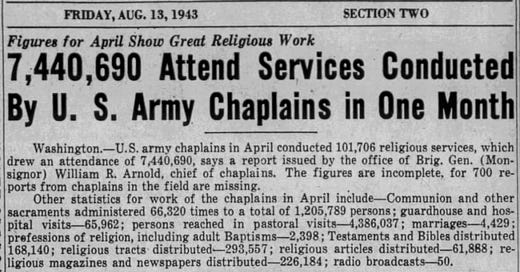The statistics (though let’s not reduce the faithful to mere numbers) in the above clipping from the August 1943 Lake Shore Visitor (Diocese of Erie, PA) tell a great story but it should be noted that the activity does not include chaplain reports from the Navy so imagine the total reach of pastoral care in just one month of the Second World War, April 1943.
From Battlefield Chaplains: Catholic Priests in World War II (University Press of Kansas, 1994) by Donald Crosby, SJ:
“The chaplain comes with two commissions - that of the Church which provides him with power from on High; that from the Nation which indicates his sphere of duty. He is simply a minister of God working in military conditions.”
Chaplains were once part of the Military Ordinariate which in simplest terms may be thought of as a diocese.
The mission of chaplains of the Military Ordinariate in World War II is outlined in author Brendan Finn’s Twenty-Four American Cardinals (Pub. by Bruce Humphries, 1947). New York’s archbishop, Francis Spellman, was the Apostolic Vicar for the Armed Forces. Under his direction, Finn writes (emphasis mine):
The work of the Military Ordinariate …
brought to America’s fighting men an astounding revelation of the unity and universality of the church. No matter where they have gone, they have found their fellow co-religionists, black and white, yellow and brown, in the bomb-battered churches of London and in the grass-thatched chapels of the Pacific reverently offering the same Mass and earnestly yearning for the same Body and Blood of Christ.
Through the Military Ordinariate (Spellman) has supervised and inspired the greatest mass missionary activity in the history of the Church in America - and possibly in the modern age.
The “Khaki-Christs” have lived and labored and died to keep marching men in step with Christ.
The Military Ordinate no longer exists, instead, today Catholic chaplains are priests of the Archdiocese for the Military Services USA, established in 1985 by John Paul II. The mission remains the same.




